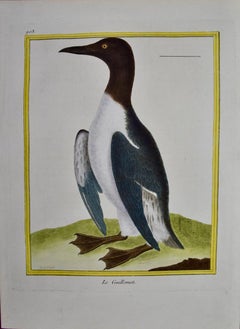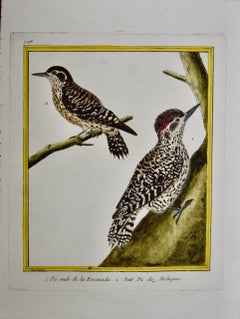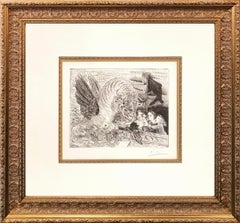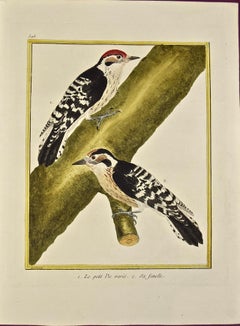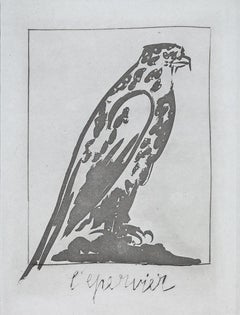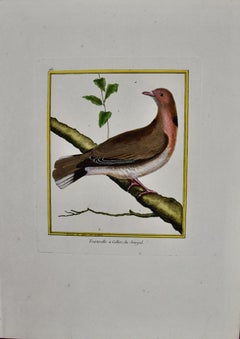Engraving Animal Prints
to
13
15
4
13
Overall Width
to
Overall Height
to
12
5
29
17
15
11
10
17
15
1
1
1
17
30
2
21
19
6
5
4
2
2
2
2
2
2
2
1
1
1
1
1
1
1
32
21
17
13
13
14
12
30
2
Artist: Pablo Picasso
Artist: Francois Nicolas Martinet
Medium: Engraving
Black Guillemot: An 18th Century Hand-colored Bird Engraving by Martinet
Located in Alamo, CA
This is a hand-colored engraving of a black guillemot bird entitled "Le Guillemot" by Francois Nicolas Martinet, plate 903 from 'Histoire Naturelle des Oiseaux' in association with G...
Category
1760s Naturalistic Engraving Animal Prints
Materials
Engraving
A Pair of Woodpeckers: An 18th Century Hand-colored Bird Engraving by Martinet
Located in Alamo, CA
This is an original 18th century hand-colored copperplate engraving of male and female woodpecker birds entitled "1. Pie Male de la Encenada, 2. Petit Pic des Moluques (Woodpeckers)"...
Category
1760s Naturalistic Engraving Animal Prints
Materials
Engraving
TAUREAU AILE CONTEMPLE PAR QUATRE ENFANTS (BLOCH 229)
Located in Aventura, FL
Plate 13 from La Suite Vollard. Bloch 229. Baer 444. Etching on Montval paper. Signed in pencil, from the edition of 260 (there was also an edition of 50 with larger margins). Printe...
Category
1930s Cubist Engraving Animal Prints
Materials
Paper, Engraving
$31,600 Sale Price
29% Off
Woodpeckers "Le Petit Pic" An 18th Century Hand-colored Engraving by Martinet
Located in Alamo, CA
This is a hand-colored engraving of male and female woodpeckers entitled "1. Le Petit Pie varie, 2. Sa Femelle" by Francois Nicolas Martinet, plate 598 from 'Histoire Naturelle des O...
Category
1760s Naturalistic Engraving Animal Prints
Materials
Engraving
The Sparrow Hawk, 1942 (Histoire Naturelle - Textes de Buffon, B.342)
Located in Greenwich, CT
The Sparrow Hawk is an aquatint and drypoint print on chine from one of the deluxe copies of Picasso's 1942 Histoire Naturelle - Textes de Buffon series. The image size is 10.5 x 8 inches, unsigned as issued, and framed in a contemporary silver and gray moulding. One of about 36 prints that exist with Picasso's remarqued title in French, from the edition of 262 (there were 226 portfolios, some with additional sets on varying papers).
Catalogue - Cramer #37
The exceptional etchings from Picasso’s Histoire Naturelle – Textes de Buffon are a masterful combination of sugar-lift aquatint and drypoint, showcasing a full range of gray tonalities. The etchings of animals, birds and insects are considered some of the most beautiful and most unusual examples of Picasso’s graphic work.
Roger Lacourière, Picasso’s master printer, pulled the prints for each etching between 1939-1942. It was Lacourière who taught Picasso the sugar-lift aquatint technique which allowed him to mimic the effect of brushstrokes in these etched images. Picasso first explored the technique in his plates for the Vollard Suite, but it was in the creation of the Buffon images that he fully realized its stunning, painterly potential.
For the edition, 226 portfolios were produced with the first thirty-six counting as deluxe compilations. These rare deluxe sets were on diverse papers (chine, japon or vergé ancien) and each included a complete additional suite showing Picasso’s title remarques along the bottom. As such, the remarqued versions of the prints are quite rare with just thirty-six of each produced for the edition (with the exception of The Wolf which is never remarqued – the image always fills the entire etching plate).
These prints are based on the writings of French naturalist Georges-Louis Leclerc, Comte de Buffon, who extensively documented the natural world in his monumental work Histoire Naturelle. Picasso’s association with the project to illustrate parts of the Buffon came during a tumultuous time in European history – the prelude to, and early years of, World War II. As the continent was ravaged, Picasso lived through the disaster in Paris, which the Germans occupied in 1940. These prints could be seen as a political statement – Picasso channeling his artistic expression into a form of resistance art...
Category
20th Century Modern Engraving Animal Prints
Materials
Drypoint, Aquatint
Turtledove of Senegal: An 18th Century Hand-colored Bird Engraving by Martinet
Located in Alamo, CA
This is a hand-colored engraving of a turtledove entitled "Tourterelle a Collier, du Senegal (Turtledove of Senegal)" by Francois Nicolas Martinet, plate 161 from 'Histoire Naturelle...
Category
1760s Naturalistic Engraving Animal Prints
Materials
Engraving
The Pigeon, 1942 (Histoire Naturelle - Textes de Buffon, B.347)
Located in Greenwich, CT
The Pigeon is an aquatint and drypoint print on chine from one of the deluxe copies of Picasso's 1942 Histoire Naturelle - Textes de Buffon series. The image size is 10.75x 8 inches, unsigned as issued, and framed in a contemporary silver and gray moulding. One of about 36 prints that exist with Picasso's remarqued title in French, from the edition of 262 (there were 226 portfolios, some with additional sets on varying papers).
Catalogue - Cramer #37
The exceptional etchings from Picasso’s Histoire Naturelle – Textes de Buffon are a masterful combination of sugar-lift aquatint and drypoint, showcasing a full range of gray tonalities. The etchings of animals, birds and insects are considered some of the most beautiful and most unusual examples of Picasso’s graphic work.
Roger Lacourière, Picasso’s master printer, pulled the prints for each etching between 1939-1942. It was Lacourière who taught Picasso the sugar-lift aquatint technique which allowed him to mimic the effect of brushstrokes in these etched images. Picasso first explored the technique in his plates for the Vollard Suite, but it was in the creation of the Buffon images that he fully realized its stunning, painterly potential.
For the edition, 226 portfolios were produced with the first thirty-six counting as deluxe compilations. These rare deluxe sets were on diverse papers (chine, japon or vergé ancien) and each included a complete additional suite showing Picasso’s title remarques along the bottom. As such, the remarqued versions of the prints are quite rare with just thirty-six of each produced for the edition (with the exception of The Wolf which is never remarqued – the image always fills the entire etching plate).
These prints are based on the writings of French naturalist Georges-Louis Leclerc, Comte de Buffon, who extensively documented the natural world in his monumental work Histoire Naturelle. Picasso’s association with the project to illustrate parts of the Buffon came during a tumultuous time in European history – the prelude to, and early years of, World War II. As the continent was ravaged, Picasso lived through the disaster in Paris, which the Germans occupied in 1940. These prints could be seen as a political statement – Picasso channeling his artistic expression into a form of resistance art...
Category
20th Century Modern Engraving Animal Prints
Materials
Drypoint, Aquatint
The Mother Hen, 1942 (Histoire Naturelle - Textes de Buffon, B.345)
Located in Greenwich, CT
The Mother Hen is an aquatint and drypoint print on chine from one of the deluxe copies of Picasso's 1942 Histoire Naturelle - Textes de Buffon series. The image size is 10.6 x 8 inc...
Category
20th Century Modern Engraving Animal Prints
Materials
Drypoint, Aquatint
The Goldfinch, 1942 (Histoire Naturelle - Textes de Buffon, B.348 )
Located in Greenwich, CT
The Goldfinch is an aquatint and drypoint print on chine from one of the deluxe copies of Picasso's 1942 Histoire Naturelle - Textes de Buffon series. The image size is 11.2 x 8.25 inches, unsigned as issued, and framed in a contemporary silver and gray moulding. One of about 36 prints that exist with Picasso's remarqued title in French, from the edition of 262 (there were 226 portfolios, some with additional sets on varying papers).
Catalogue - Cramer #37
The exceptional etchings from Picasso’s Histoire Naturelle – Textes de Buffon are a masterful combination of sugar-lift aquatint and drypoint, showcasing a full range of gray tonalities. The etchings of animals, birds and insects are considered some of the most beautiful and most unusual examples of Picasso’s graphic work.
Roger Lacourière, Picasso’s master printer, pulled the prints for each etching between 1939-1942. It was Lacourière who taught Picasso the sugar-lift aquatint technique which allowed him to mimic the effect of brushstrokes in these etched images. Picasso first explored the technique in his plates for the Vollard Suite, but it was in the creation of the Buffon images that he fully realized its stunning, painterly potential.
For the edition, 226 portfolios were produced with the first thirty-six counting as deluxe compilations. These rare deluxe sets were on diverse papers (chine, japon or vergé ancien) and each included a complete additional suite showing Picasso’s title remarques along the bottom. As such, the remarqued versions of the prints are quite rare with just thirty-six of each produced for the edition (with the exception of The Wolf which is never remarqued – the image always fills the entire etching plate).
These prints are based on the writings of French naturalist Georges-Louis Leclerc, Comte de Buffon, who extensively documented the natural world in his monumental work Histoire Naturelle. Picasso’s association with the project to illustrate parts of the Buffon came during a tumultuous time in European history – the prelude to, and early years of, World War II. As the continent was ravaged, Picasso lived through the disaster in Paris, which the Germans occupied in 1940. These prints could be seen as a political statement – Picasso channeling his artistic expression into a form of resistance art...
Category
20th Century Modern Engraving Animal Prints
Materials
Drypoint, Aquatint
The Monkey, 1942 (Histoire Naturelle - Textes de Buffon, B.339)
Located in Greenwich, CT
The Monkey is an aquatint and drypoint print on chine from one of the deluxe copies of Picasso's 1942 Histoire Naturelle - Textes de Buffon series. The image size is 10.5 x 7.9 inche...
Category
20th Century Modern Engraving Animal Prints
Materials
Drypoint, Aquatint
The Lobster, 1942 (Histoire Naturelle - Textes de Buffon, B.352)
Located in Greenwich, CT
The Lobster is an aquatint and drypoint print on chine from one of the deluxe copies of Picasso's 1942 Histoire Naturelle - Textes de Buffon series. The image size is 10.6 x 7.9 inches, unsigned as issued, and framed in a contemporary silver and gray moulding. One of about 36 prints that exist with Picasso's remarqued title in French, from the edition of 262 (there were 226 portfolios, some with additional sets on varying papers).
Catalogue - Cramer #37
The exceptional etchings from Picasso’s Histoire Naturelle – Textes de Buffon are a masterful combination of sugar-lift aquatint and drypoint, showcasing a full range of gray tonalities. The etchings of animals, birds and insects are considered some of the most beautiful and most unusual examples of Picasso’s graphic work.
Roger Lacourière, Picasso’s master printer, pulled the prints for each etching between 1939-1942. It was Lacourière who taught Picasso the sugar-lift aquatint technique which allowed him to mimic the effect of brushstrokes in these etched images. Picasso first explored the technique in his plates for the Vollard Suite, but it was in the creation of the Buffon images that he fully realized its stunning, painterly potential.
For the edition, 226 portfolios were produced with the first thirty-six counting as deluxe compilations. These rare deluxe sets were on diverse papers (chine, japon or vergé ancien) and each included a complete additional suite showing Picasso’s title remarques along the bottom. As such, the remarqued versions of the prints are quite rare with just thirty-six of each produced for the edition (with the exception of The Wolf which is never remarqued – the image always fills the entire etching plate).
These prints are based on the writings of French naturalist Georges-Louis Leclerc, Comte de Buffon, who extensively documented the natural world in his monumental work Histoire Naturelle. Picasso’s association with the project to illustrate parts of the Buffon came during a tumultuous time in European history – the prelude to, and early years of, World War II. As the continent was ravaged, Picasso lived through the disaster in Paris, which the Germans occupied in 1940. These prints could be seen as a political statement – Picasso channeling his artistic expression into a form of resistance art...
Category
20th Century Modern Engraving Animal Prints
Materials
Drypoint, Aquatint
Colorful Parrot: An 18th Century Hand-colored Bird Engraving by Martinet
Located in Alamo, CA
This is a hand-colored engraving of a parrot bird entitled "La Perruche-Ara, de Cayenne (Parrot)" by Francois Nicolas Martinet, plate 864 from 'Histoire Naturelle des Oiseaux' in ass...
Category
1760s Naturalistic Engraving Animal Prints
Materials
Engraving
Le Singe - Etching by Pablo Picasso - 1940s
Located in Roma, IT
Etching, aquatint and drypoint. Not Signed and not Numbered as issued.
Edition of 226 pieces.
Belongs to the Suite "Histoire Naturelle de Buffon" (plate p. 86).
Printed by Lacourièr...
Category
1940s Cubist Engraving Animal Prints
Materials
Paper, Etching, Drypoint, Aquatint
Le Millouinan /// Ornithology Martinet Bird Animal Art Duck Natural History
Located in Saint Augustine, FL
Artist: François-Nicolas Martinet (French, 1731-1800)
Title: "Le Millouinan" (Plate 1002)
Portfolio: Histoire Naturelle Des Oiseaux
*Signed by Martinet in the plate (printed signatur...
Category
1770s Old Masters Engraving Animal Prints
Materials
Watercolor, Laid Paper, Engraving, Intaglio
Bird of Prey: An 18th Century Hand-colored Bird Engraving by Martinet
Located in Alamo, CA
This is a hand-colored engraving of a parrot bird entitled "La Bondree (Bird of Prey)" by Francois Nicolas Martinet, plate 420 from 'Histoire Naturelle des Oiseaux' in association wi...
Category
1760s Naturalistic Engraving Animal Prints
Materials
Engraving
Red & Black Woodpeckers: An 18th Century Hand-colored Bird Engraving by Martinet
Located in Alamo, CA
This is an original 18th century hand-colored copperplate engraving of a pair of red and black woodpecker birds entitled "1. Pie Roux, de Cayenne 2. Petit Pie Noir, de Cayenne (Red a...
Category
1760s Naturalistic Engraving Animal Prints
Materials
Engraving
Turtledove: An 18th Century Hand-colored Bird Engraving by Martinet
Located in Alamo, CA
This is a hand-colored engraving of a turtledove entitled "Tourterelle du Senegal (Turtledove of Senegal)" by Francois Nicolas Martinet, plate 160 from 'Histoire Naturelle des Oiseau...
Category
1760s Naturalistic Engraving Animal Prints
Materials
Engraving
Sacelle male, de la cote de Coromandel /// Ornithology Martinet Bird Animal Art
Located in Saint Augustine, FL
Artist: François-Nicolas Martinet (French, 1731-1800)
Title: "Sacelle male, de la cote de Coromandel" (Plate 949)
Portfolio: Histoire Naturelle Des Oiseaux
*Signed by Martinet in the...
Category
1770s Old Masters Engraving Animal Prints
Materials
Watercolor, Laid Paper, Engraving, Intaglio
A Greenfinch & A Sparrow: An 18th Century Hand-colored Engraving by Martinet
Located in Alamo, CA
This is a hand-colored engraving of a Greenfinch bird and a tree sparrow ("1, Le Friquet, 2. Le Verdier") by Francois Nicolas Martinet, plate 227 from 'Histoire Naturelle des Oiseaux...
Category
1760s Naturalistic Engraving Animal Prints
Materials
Engraving
Le Canard a Longue Queue (The Long Tailed Duck) /// Ornithology Martinet Bird
Located in Saint Augustine, FL
Artist: François-Nicolas Martinet (French, 1731-1800)
Title: "Le Canard a Longue Queue (The Long Tailed Duck)" (Plate 954)
Portfolio: Histoire Naturelle Des Oiseaux
*Signed by Martin...
Category
1770s Old Masters Engraving Animal Prints
Materials
Watercolor, Laid Paper, Engraving, Intaglio
Le Harle Femell (The Female Merganser) /// Ornithology Martinet Bird Animal Art
Located in Saint Augustine, FL
Artist: François-Nicolas Martinet (French, 1731-1800)
Title: "Le Harle Femell (The Female Merganser)" (Plate 953)
Portfolio: Histoire Naturelle Des Oiseaux
*Signed by Martinet in the...
Category
1770s Old Masters Engraving Animal Prints
Materials
Watercolor, Laid Paper, Engraving, Intaglio
Canard de Miclon (Old Squaw) /// Ornithology Martinet Bird Animal Art Duck
Located in Saint Augustine, FL
Artist: François-Nicolas Martinet (French, 1731-1800)
Title: "Canard de Miclon (Old Squaw)" (1008)
Portfolio: Histoire Naturelle Des Oiseaux
*Signed by Martinet in the plate (printed...
Category
1770s Old Masters Engraving Animal Prints
Materials
Watercolor, Laid Paper, Engraving, Intaglio
A Falkland Island Quail: An 18th Century Hand-colored Engraving by Martinet
Located in Alamo, CA
This is a hand-colored engraving of a Falkland Island Quail ("Caille des Isles Malouines") by Francois Nicolas Martinet, plate 222 from 'Histoire Naturelle des Oiseaux' in associatio...
Category
1760s Naturalistic Engraving Animal Prints
Materials
Engraving
An Icelandic GyrFalcon: An 18th Century Hand-colored Engraving by Martinet
Located in Alamo, CA
This is a hand-colored engraving of an Icelandic Ger Falcon entitled "Gerfault d''Islande" by Francois Nicolas Martinet, plate 210 from 'Histoire Naturelle des Oiseaux' in associatio...
Category
1760s Naturalistic Engraving Animal Prints
Materials
Engraving
Francois Nicolas Martinet (1731-1804) - Engraving, Petite Outarde ou Canepetiere
Located in Corsham, GB
This hand-colored engraving comes from "Histoire Naturelle Des Oiseaux," a famous set of volumes edited by Georges Louis Leclerc, le comte de Buffon (1707-1788). The book was publish...
Category
Early 18th Century Engraving Animal Prints
Materials
Engraving
The Deer, 1942 (Histoire Naturelle - Textes de Buffon, B.336)
Located in Greenwich, CT
The Deer is an aquatint and drypoint print on chine from one of the deluxe copies of Picasso's 1942 Histoire Naturelle - Textes de Buffon series. The image size is 10.5 x 8.15 inches, unsigned as issued, and framed in a contemporary silver and gray moulding. One of about 36 prints that exist with Picasso's remarqued title in French, from the edition of 262 (there were 226 portfolios, some with additional sets on varying papers).
Catalogue - Cramer #37
The exceptional etchings from Picasso’s Histoire Naturelle – Textes de Buffon are a masterful combination of sugar-lift aquatint and drypoint, showcasing a full range of gray tonalities. The etchings of animals, birds and insects are considered some of the most beautiful and most unusual examples of Picasso’s graphic work.
Roger Lacourière, Picasso’s master printer, pulled the prints for each etching between 1939-1942. It was Lacourière who taught Picasso the sugar-lift aquatint technique which allowed him to mimic the effect of brushstrokes in these etched images. Picasso first explored the technique in his plates for the Vollard Suite, but it was in the creation of the Buffon images that he fully realized its stunning, painterly potential.
For the edition, 226 portfolios were produced with the first thirty-six counting as deluxe compilations. These rare deluxe sets were on diverse papers (chine, japon or vergé ancien) and each included a complete additional suite showing Picasso’s title remarques along the bottom. As such, the remarqued versions of the prints are quite rare with just thirty-six of each produced for the edition (with the exception of The Wolf which is never remarqued – the image always fills the entire etching plate).
These prints are based on the writings of French naturalist Georges-Louis Leclerc, Comte de Buffon, who extensively documented the natural world in his monumental work Histoire Naturelle. Picasso’s association with the project to illustrate parts of the Buffon came during a tumultuous time in European history – the prelude to, and early years of, World War II. As the continent was ravaged, Picasso lived through the disaster in Paris, which the Germans occupied in 1940. These prints could be seen as a political statement – Picasso channeling his artistic expression into a form of resistance art...
Category
20th Century Modern Engraving Animal Prints
Materials
Drypoint, Aquatint
The Donkey, 1942 (Histoire Naturelle - Textes de Buffon, B.329)
Located in Greenwich, CT
The Donkey is an aquatint and drypoint print on chine from one of the deluxe copies of Picasso's 1942 Histoire Naturelle - Textes de Buffon series. The image size is 10.5 x 8 inches,...
Category
20th Century Modern Engraving Animal Prints
Materials
Drypoint, Aquatint
The Rooster, 1942 (Histoire Naturelle - Textes de Buffon, B.344)
Located in Greenwich, CT
The Rooster is an aquatint and drypoint print on chine from one of the deluxe copies of Picasso's 1942 Histoire Naturelle - Textes de Buffon series. The image size is 10.6 x 8.15 inc...
Category
20th Century Modern Engraving Animal Prints
Materials
Drypoint, Aquatint
The Vulture. 1942 (Histoire Naturelle - Textes de Buffon, B.341)
Located in Greenwich, CT
The Vulture is an aquatint and drypoint print on chine from one of the deluxe copies of Picasso's 1942 Histoire Naturelle - Textes de Buffon series. The image size is 10.6 x 8 inches, unsigned as issued, and framed in a contemporary silver and gray moulding. One of about 36 prints that exist with Picasso's remarqued title in French, from the edition of 262 (there were 226 portfolios, some with additional sets on varying papers).
Catalogue - Cramer #37
The exceptional etchings from Picasso’s Histoire Naturelle – Textes de Buffon are a masterful combination of sugar-lift aquatint and drypoint, showcasing a full range of gray tonalities. The etchings of animals, birds and insects are considered some of the most beautiful and most unusual examples of Picasso’s graphic work.
Roger Lacourière, Picasso’s master printer, pulled the prints for each etching between 1939-1942. It was Lacourière who taught Picasso the sugar-lift aquatint technique which allowed him to mimic the effect of brushstrokes in these etched images. Picasso first explored the technique in his plates for the Vollard Suite, but it was in the creation of the Buffon images that he fully realized its stunning, painterly potential.
For the edition, 226 portfolios were produced with the first thirty-six counting as deluxe compilations. These rare deluxe sets were on diverse papers (chine, japon or vergé ancien) and each included a complete additional suite showing Picasso’s title remarques along the bottom. As such, the remarqued versions of the prints are quite rare with just thirty-six of each produced for the edition (with the exception of The Wolf which is never remarqued – the image always fills the entire etching plate).
These prints are based on the writings of French naturalist Georges-Louis Leclerc, Comte de Buffon, who extensively documented the natural world in his monumental work Histoire Naturelle. Picasso’s association with the project to illustrate parts of the Buffon came during a tumultuous time in European history – the prelude to, and early years of, World War II. As the continent was ravaged, Picasso lived through the disaster in Paris, which the Germans occupied in 1940. These prints could be seen as a political statement – Picasso channeling his artistic expression into a form of resistance art...
Category
20th Century Modern Engraving Animal Prints
Materials
Aquatint, Drypoint
The Spider, 1942 (Histoire Naturelle - Textes de Buffon, B.353)
Located in Greenwich, CT
The Spider is an aquatint and drypoint print on chine from one of the deluxe copies of Picasso's 1942 Histoire Naturelle - Textes de Buffon series. The image size is 10.5 x 8 inches, unsigned as issued, and framed in a contemporary silver and gray moulding. One of about 36 prints that exist with Picasso's remarqued title in French, from the edition of 262 (there were 226 portfolios, some with additional sets on varying papers).
Catalogue - Cramer #37
The exceptional etchings from Picasso’s Histoire Naturelle – Textes de Buffon are a masterful combination of sugar-lift aquatint and drypoint, showcasing a full range of gray tonalities. The etchings of animals, birds and insects are considered some of the most beautiful and most unusual examples of Picasso’s graphic work.
Roger Lacourière, Picasso’s master printer, pulled the prints for each etching between 1939-1942. It was Lacourière who taught Picasso the sugar-lift aquatint technique which allowed him to mimic the effect of brushstrokes in these etched images. Picasso first explored the technique in his plates for the Vollard Suite, but it was in the creation of the Buffon images that he fully realized its stunning, painterly potential.
For the edition, 226 portfolios were produced with the first thirty-six counting as deluxe compilations. These rare deluxe sets were on diverse papers (chine, japon or vergé ancien) and each included a complete additional suite showing Picasso’s title remarques along the bottom. As such, the remarqued versions of the prints are quite rare with just thirty-six of each produced for the edition (with the exception of The Wolf which is never remarqued – the image always fills the entire etching plate).
These prints are based on the writings of French naturalist Georges-Louis Leclerc, Comte de Buffon, who extensively documented the natural world in his monumental work Histoire Naturelle. Picasso’s association with the project to illustrate parts of the Buffon came during a tumultuous time in European history – the prelude to, and early years of, World War II. As the continent was ravaged, Picasso lived through the disaster in Paris, which the Germans occupied in 1940. These prints could be seen as a political statement – Picasso channeling his artistic expression into a form of resistance art...
Category
20th Century Modern Engraving Animal Prints
Materials
Drypoint, Aquatint
The Wasp, 1942 (Histoire Naturelle - Textes de Buffon, B.351)
Located in Greenwich, CT
The Wasp is an aquatint and drypoint print on chine from one of the deluxe copies of Picasso's 1942 Histoire Naturelle - Textes de Buffon series. The image size is 10.6 x 8 inches, u...
Category
20th Century Modern Engraving Animal Prints
Materials
Drypoint, Aquatint
MAMELOUK ENLEVANT UNE FEMME, ATTAQUE PAR UN MOUSQUETAIRE (BLOCH 1586)
Located in Aventura, FL
Aquatint on wove paper. Hand signed and numbered by Pablo Picasso. Plate 106, from the serie "347 gravures" (B. 1586; BA. 1602 II B b 1). Published by Galerie Louise Leiris, Paris. ...
Category
1960s Cubist Engraving Animal Prints
Materials
Paper, Engraving
$15,600 Sale Price
20% Off
Engraving animal prints for sale on 1stDibs.
Find a wide variety of authentic Engraving animal prints available on 1stDibs. While artists have worked in this medium across a range of time periods, art made with this material during the 18th Century is especially popular. If you’re looking to add animal prints created with this material to introduce a provocative pop of color and texture to an otherwise neutral space in your home, the works available on 1stDibs include elements of green and other colors. There are many well-known artists whose body of work includes ceramic sculptures. Popular artists on 1stDibs associated with pieces like this include Salvador Dalí, Pablo Picasso, Edmund Blampied, and Francois Nicolas Martinet. Not every interior allows for large Engraving animal prints, so small editions measuring 8 inches across are also available Prices for animal prints made by famous or emerging artists can differ depending on medium, time period and other attributes. On 1stDibs, the price for these items starts at $350 and tops out at $460, while the average work can sell for $380.
Still Thinking About These?
All Recently ViewedMore Ways To Browse
Le Singe Et Le Leopard
Leon Danchin On Sale
Louis Prang Chromolithograph
Man O War Horse
Manetti Saverio
Natural History Museum Vintage Prints
Penguin Lithograph
Peter Klucik
Pheasant Engraving
Picasso Dove Of Peace
Picasso Le Taureau
Picasso Rooster
Ronald Smith
Rooster Print Picasso
Salvador Dali Argus
Salvador Dali Unicorn
Sam Savitt
Shore Bird Print
